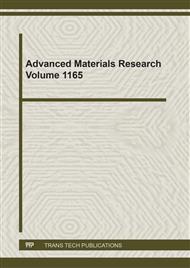[1]
B. Han Y. Shimizu, G. Seguini, E. Arduca, C. Castro, G. Benassayag, Y. Nagai, S. Shamm-Chardon, M. Perego., Evolution of shape, size, and areal density of a single plane of Si nanocrystals embedded in SiO2 matrix studied by atom probe tomography, RSC Adv., 6, 5, (2016) 3617–3622.
DOI: 10.1039/c5ra26710b
Google Scholar
[2]
J. A. Luna López D. E. Vázquez Valerdi, A. Benítez Lara, G. García Salgado, A. D. Hernández -de la Luz, A. Morales Sánchez, F. J. Flores Gracia and M. A. Dominguez, Optical and Compositional Properties of SiOx Films Deposited by HFCVD: Effect of the Hydrogen Flow, J. Electron. Mater., 46, 4, (2017) 2309–2322.
DOI: 10.1007/s11664-016-5271-1
Google Scholar
[3]
V. N. Kruchinin, T. V. Perevalov, G. N. Kamaev, S.V. Rykhlitskii, and V. A. Gritsenko, Optical Properties of Nonstoichiometric Silicon Oxide SiOx (x<2). Opt and Spectrosc., 127, 5 (2019) 836-840.
DOI: 10.1134/s0030400x19110183
Google Scholar
[4]
W. L. Zhang, S. Zhang, M. Yang, Z. Liu, and T. P. Chen, Charging effect on conductance of magnetron sputtered Si nanocrystals embedded SiO2 films, Nanosci. Nanotechnol. Lett., 2, 3, (2010) 226–230.
DOI: 10.1166/nnl.2010.1074
Google Scholar
[5]
J. Bornacelli, J. A. Reyes Esqueda, L. Rodríguez Fernández, and A. Oliver, Improving passivation process of Si nanocrystals embedded in SiO Using Metal Ion Implantation, J. Nanotechnol, (2013) 1-9.
DOI: 10.1155/2013/736478
Google Scholar
[6]
A. Benítez-Lara, G. García-Salgado, D. E. Vázquez-Valerdi, A. Morales-Sánchez, N. D. Espinosa-Torres, and J. A. Luna-López, Silicon rich oxide powders by HWCVD: Its optical and morphological properties, Adv. Powder Technol. 26, 1, (2015) 163–16.
DOI: 10.1016/j.apt.2014.09.005
Google Scholar
[7]
L. Schäfer, M. Höfer, R. Kröger, The versatility of hot-filament activated chemical vapor deposition, Thin Solid Films, 515 (2006) 1017-1024.
DOI: 10.1016/j.tsf.2006.07.073
Google Scholar
[8]
H. Ma, J. Yang. J. Yang, L. Zhu, W. Huang, G. Yuan, J. Feng, T. Jen and H. Lu, Systematic Study of the SiOx Film with Different Stoichiometry by PLasma-Enhanced Atomic Layer Deposition and Its Application in SiOx/SiO2 Super-Lattice, Nanomater, 9, 55 (2019).
DOI: 10.3390/nano9010055
Google Scholar
[9]
K. Choi and J.-W. Kim, "CFD Simulation of Chemical Vapor Deposition of Silicon Carbide in CH3SiCl3-H2 System, Curr. Nanosci., 10, 1, (2014) 135–137.
Google Scholar
[10]
C. W. Song, Y. H. Lee, S. Y. Heo, N. M. Hwang, S. Choi, and K. H. Kim, Computer simulation of temperature parameter for diamond formation by using hot-filament chemical vapor deposition, Coatings, 8 (1), (2018) 15.
DOI: 10.3390/coatings8010015
Google Scholar
[11]
D. C. Barbosa, H. F. V. Nova, and M. R. Baldan, Numerical simulation of HFCVD process used for diamond growth, Brazilian J. Phys., 36, 2 (2006) 313–316.
DOI: 10.1590/s0103-97332006000300021
Google Scholar
[12]
G. Luo, S. P. Vanka, and N. Glumac, Fluid flow and transport processes in a large area atmospheric pressure stagnation flow CVD reactor for deposition of thin films," Int. J. Heat Mass Transf., 47, 23, (2004) 4979–4994.
DOI: 10.1016/j.ijheatmasstransfer.2004.06.012
Google Scholar
[13]
H. Ni, S. Lu, and C. Chen, Modeling and simulation of silicon epitaxial growth in SiemensCVD reactor, J. Cryst. Growth, 404, (2014) 89–99.
DOI: 10.1016/j.jcrysgro.2014.07.006
Google Scholar
[14]
A. Dollet, Multiscale modeling of CVD film growth-a review of recent works, Surf. Coatings Technol., 177–178, (2004) 245–251.
DOI: 10.1016/j.surfcoat.2003.09.040
Google Scholar
[15]
T. Zhang, J. Zhang, B. Shen, and F. Sun, Simulation of temperature and gas density field distribution in diamond films growth on silicon wafer by hot filament CVD, J. Cryst. Growth, 343,1, (2012) 55–61.
DOI: 10.1016/j.jcrysgro.2012.01.005
Google Scholar
[16]
K. C. Topka, G. A. Chliavoras, F. Senocq, Hugues Vergnes, D. Samelor, D. Sadowski, C. Vahlas, Brigitte Caussant, Large temperature range model for the atmospheric pressure chemical vapor deposition of silicon dioxide films on the thermosensitive substrates, Chem. Eng. Res.Des, 161 (2020) 146-158.
DOI: 10.1016/j.cherd.2020.07.007
Google Scholar
[17]
J. A. Luna López, D. E. Vázquez Valerdi, A. Benítez Lara, G. García Salgado, A. D. Hernández de la Luz, A. Morales Sánchez, F. J. Flores Gracia, and M.A. Dominguez,J. Electron Mater, 46, (2017) 4.
DOI: 10.1007/s11664-016-5271-1
Google Scholar
[18]
H. H. El-badrawi, E. S. Hafez, M. Fayad, and A. Shafeek, Transport Phenomena, second edition New York, (2002).
Google Scholar
[19]
Martínez Hernández H. P., Luna López J. A., David Hernández de la Luz J. A., Luna Flores A., Monfil Leyva K., García Salgado G., Carrillo López J., Ordoñez Flores R., Pérez García S.A., Hernández Simón Z. J., Mendoza Conde G. O. and Raquel Ramírez Amador, Spectroscopic and Microscopic Correlation of SRO-HFCVD Films on Quartz and Silicon, crystals, 10, 127, (2020).
DOI: 10.3390/cryst10020127
Google Scholar
[20]
M. Riera, J. A. Rodríguez, J. Barreto, and C. Domínguez, Modeling of non-stoichiometric silicon oxides obtained by plasma enhanced chemical vapour deposition process, Thin Solid Films, 515, 7–8, (2007) 3380–3386.
DOI: 10.1016/j.tsf.2006.09.032
Google Scholar
[21]
J. Abrefah and D. R. Olander, Reaction of Atomic Hydrogen with cristalline silicon, Surf. Sci., 209, (1989) 291–313.
DOI: 10.1016/0039-6028(89)90077-0
Google Scholar
[22]
V. Verlaan, Z. S. Houweling, K. van der Werf, H. D Goldbach, and Ruud Schropp, Reaction Mechanism for Deposition of Silicon Nitride by Hot-Wire CVD with Ultra High Deposition Rate (>7 nm/s), Mater. Res. Soc., 910.
DOI: 10.1557/proc-0910-a03-03
Google Scholar


